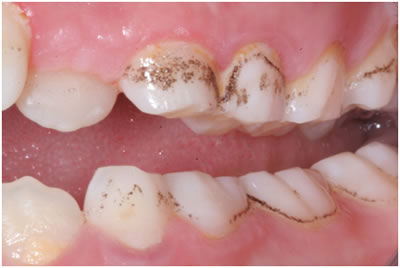Black stain on teeth

Black stain
The black stain, which is most often seen near the gum line on on both the front and back of the teeth of children, is the result of the action of chromogenic bacteria. An investigation has been carried out into the nature of the black pigment in black extrinsic tooth stain. The results suggest that the black material is a ferric salt, probably ferric sulfide, formed by the reaction between hydrogen sulfide produced by bacterial action and iron in the saliva or gingival exudate. The intensity of stains may be worsened if there are enamel defects. Many children who have black stain are either caries-free or with a low caries frequency. Iron-containing oral solutions used for treatment of iron deficiency anemia or multivitamin syrups also cause black stains.
Black stains can be removed by polishing with a rubber cup and fluor pumice using pressured water. Because stains are most often seen in mouth in which there is poor oral hygiene, improving the oral hygiene minimizes the recurrence of the stain.
Sources
McDonald RE, Avery DR, Weddell JA, John V: Gingivitis and periodontal diseases. In: Dean JA, Avery DR, McDonald RE. Dentistry for the child and adolescent. St. Louis, Mosby Elsevier, 9th ed., 2011, p:366-402
Reid JS, Beeley JA, MacDonald DG. Investigations into black extrinsic tooth stain. J Dent Res. Aug 1977;56(8):895-9
Hattab FN, Qudeimat MA, al-Rimawi HS. Dental discoloration: an overview. J Esthet Dent. 1999;11(6):291-310
http://www.aapd.org/media/Policies_Guidelines/G_Prophylaxis.pdf 2011-2012





